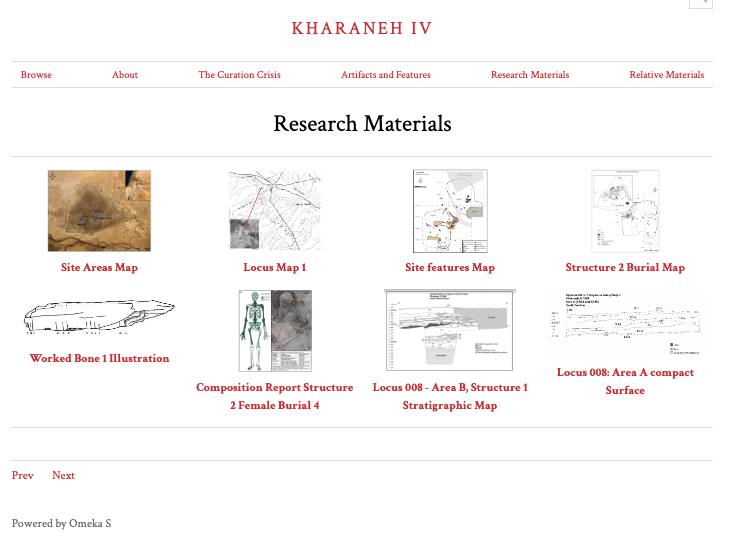Create Your First Project
Start adding your projects to your portfolio. Click on "Manage Projects" to get started
Kharaneh IV
Link
Location
Pratt School of Information, New York City
Date
Spring 2022
Class
INFO - 684 Museum Information Management
Project Description
Purpose of my project: An Overall Bare minimum of Archaeological Curation
To create exhibitions for artifacts and material evidence and discuss the importance behind the site Kharaneh IV. Currently, the only shareable format of findings is through the project's website, which mainly consists of lengthy, scientific publications, or focuses more on the fieldwork and students that attend excavation.
To make these materials ready for public access, I am assembling various artifact types, site features, people, and publications affiliated with the project.
This project will add examples of publicly shared archaeological data. Therefore, enhancing abilities for cross-analysis, research, and public knowledge. As discussed past publication is not a common practice in many archaeological sites, as they are deemed not worthy for museum halls, and much knowledge falls through. Also, many archaeologists are able to get away with not hosting all their information to the public, which is a social justice problem overall in regard to studying culture and feminist ethnography.
Methods
On this site, I am assembling scanned pages of field notes, exemplary artifacts, site features, publications, and people involved with the project into an Item Set which will serve as the container for the image Items.
Metadata for the Kharaneh IV Archaeological site itself is recorded in the Item Set metadata, while metadata on the project materials and examples are within the Item tombstone. This "test case" is demonstrating how Omeka S can serve the 21st Century Curation Crisis in Archaeology but make archaeological information and data public and accessible. Publications written for scientific minds are summarized, importance is directly discussed, and viewing of cultural materials is made possible.
This "test case" also provides examples of when we combine different mediums of archaeological materials into a collection, how we store their metadata, and making metadata for an object as interoperable as possible for any database.
Also, the additional materials page was created by accessing the library of Congress open-source API and crosswalking the metadata to match my schema, and using their images by importing CSV format into Omeka.
My Role
This project was completed entirely by myself.
Learning Outcome Achieved
Museum Information Management and Technologies
Rationale
This collections management project required my knowledge of controlled vocabularies and APIs, as well as my past archaeological research as I had worked on this project at UC Berkeley as an undergraduate. As a person who is highly invested in interoperability, I very much wanted to create a case study for using DOLMEN vocabulary in an archaeological asset and its metadata. I was able to successfully illustrate the ability of DOLMEN in scientific databases, and show the bare minimum of digitization an item is not only interoperable but helpful in the age of curation crisis and lack of digitization in archaeology. The use of DOLMEN is a solution that can be applied to future projects in archaeological archives.
Professor Feedback
"Truly a well-conceived and executed project! You have shown great care and thought for your subject matter from the beginning and it has come together as a great resource AND an important statement of the current problem. I hope that you continue to pursue this subject -- conference presentation, paper? It's so interesting and topical across disciplines. The metadata is excellent. As I said before, you can send me the citations for Dr. Lisa A. Maher's publications and I'll forward them to my contact at the Smithsonian. Maybe she can fast-track her name authority record in LC! It was a pleasure having you in class!!"
~ Iris Lee ~
"You've been a gem this whole semester. Your participation, questions, and curiosity have made it a pleasure to have you in class. Your site is great - the ambition you came to this project led to awesome results - I hope you are pleased with the way it turned out. I liked that you used your experience in the field to base your project on - it adds a personal touch. Your desire to use DOLMEN was a pleasant surprise and we learned a new metadata standard. The basic, hyper-interoperable intention of the standard is cool and has made me question some of the metadata decisions we've made at AMNH. I appreciate the amount of effort that went into gathering your materials for the collection. Above and beyond. It's great that you see information and cataloging as the answer to the questions you raise in the Curation Crisis section of your site. The explanation of your metadata template and the crosswalk to DOLMEN is well done - I really like the spirit of simplicity and interoperability. Your cataloging is solid and the collection is well-curated and compelling. Really super job! Please stay in touch - Iris and I are happy to be referenced and help in any way we can as you navigate your career."
~ Jennifer Cwiok













